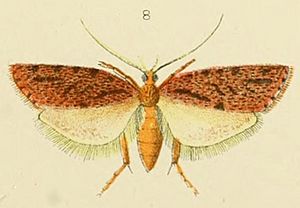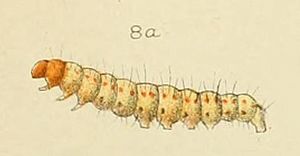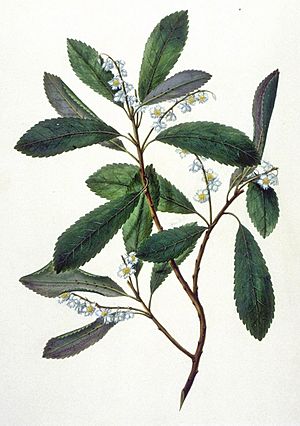Izatha attactella facts for kids
Quick facts for kids Izatha attactella |
|
|---|---|
 |
|
| Scientific classification | |
| Kingdom: | |
| Phylum: | |
| Class: | |
| Order: | |
| Family: |
Oecophoridae
|
| Genus: | |
| Species: |
I. attactella
|
| Binomial name | |
| Izatha attactella Walker, 1864
|
|
| Synonyms | |
|
|
The Izatha attactella is a type of moth that belongs to the Oecophoridae family. This special moth lives only in New Zealand. You can find it on both the North and South Islands, reaching as far south as mid-Canterbury.
Young Izatha attactella moths, called larvae, eat the soft inner part of the bark on dead trees and shrubs. Adult moths are usually seen flying from September to December.
Contents
How This Moth Got Its Name
This moth was first described by a scientist named Francis Walker in 1864. He studied specimens found in Auckland and by Mr Sinclair.
Later, in 1888, another scientist named Edward Meyrick thought he had found a new species. He named it Semiocosma platyptera. However, he later realized in 1915 that it was the same moth. So, Semiocosma platyptera became a synonym for I. attactella.
Scientists like George Hudson and Alfred Philpott also studied and wrote about this moth.
What the Izatha Attactella Looks Like
When fully grown, the larva (caterpillar) of this moth is about 2.2 centimeters (7/8 inch) long. Its head is dark brown and shiny, while its body is white.
The pupa, which is the stage before it becomes an adult moth, is a pale yellowish color. It has a brownish tint on its head and lower body. The pupa rests inside an oval-shaped cocoon. This cocoon is made from silk and small pieces of chewed bark.
Adult Izatha attactella moths have a wingspan of about 24.5 to 38 millimeters for males. Females are a bit smaller, with a wingspan of 22 to 36 millimeters.
This moth looks a bit like another species called I. voluptuosa. However, I. attactella has narrower front wings and paler back wings. It also has clearer scale tufts and a longer dark streak at the base of its wings.
You can also tell them apart by when they fly. I. attactella is active earlier in the season, from September to December. I. voluptuosa flies later, from November to February.
Where the Izatha Attactella Lives
This moth is found only in New Zealand. It is widespread across both the North and South Islands. In the South Island, it lives as far south as mid-Canterbury.
It has been found in many places, including Northland, Auckland, Waikato, Bay of Plenty, Wellington, and Marlborough.
Life Cycle and Habits
The pupa stage happens under the bark of trees. The pupa is protected inside its oval cocoon made of silk and wood pieces.
Adult moths are usually seen flying from September to December. Sometimes, in the South Island, you might spot them in December and January. If they are raised in captivity in the North Island, they can emerge as adults from July onwards.
These moths do not often fly towards lights in large numbers.
Where it Lives and What it Eats
The larvae of Izatha attactella live and feed under the bark of dead trees and shrubs. They eat the soft inner surface of the bark.
Some of the trees they are known to feed on include:
They have also been found in dead wood from other trees like Castanea, Litsea calicaris, Olearia paniculata, Pinus patula, Pinus radiata, and Sophora species. In Auckland, larvae have even been seen feeding on dead, rotting wood lying on the ground.




